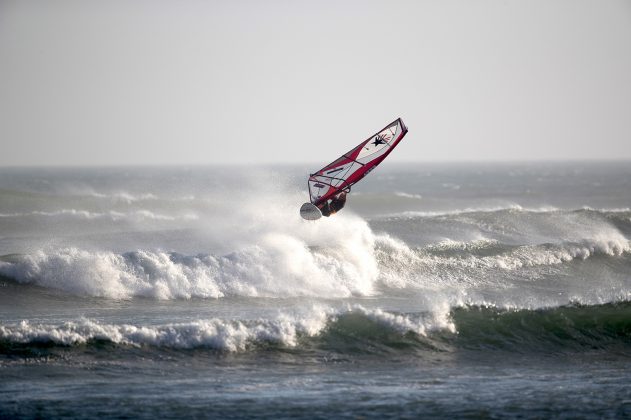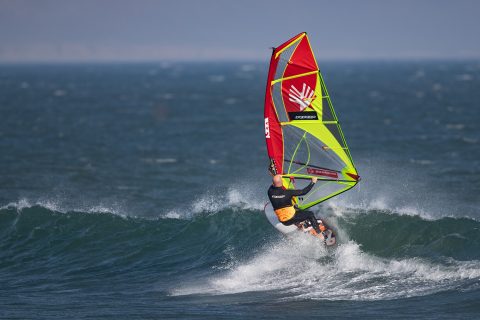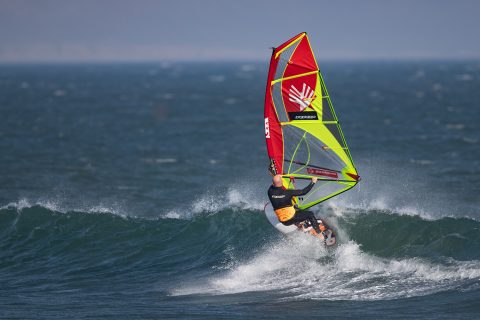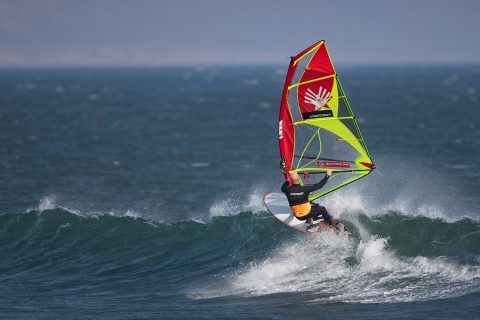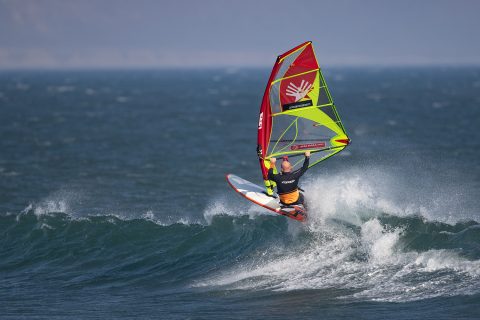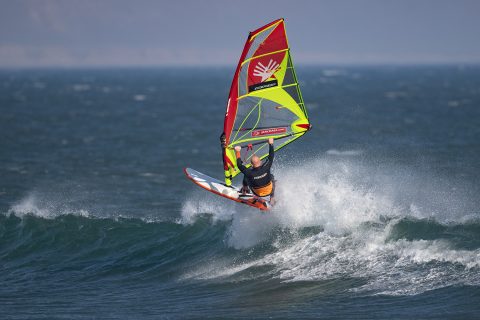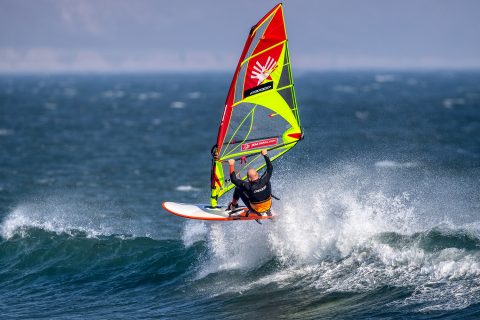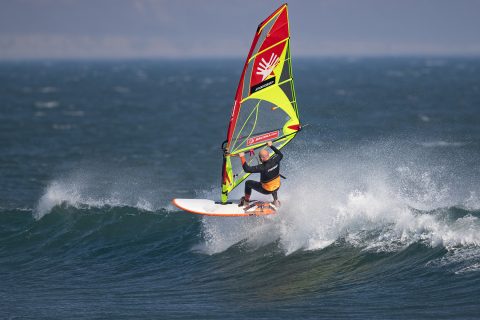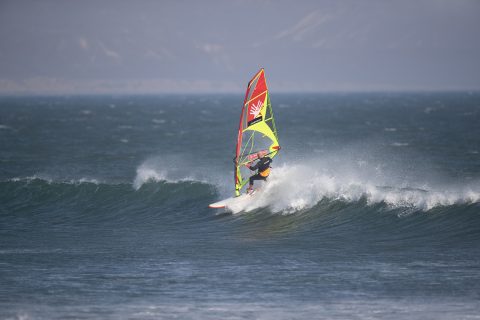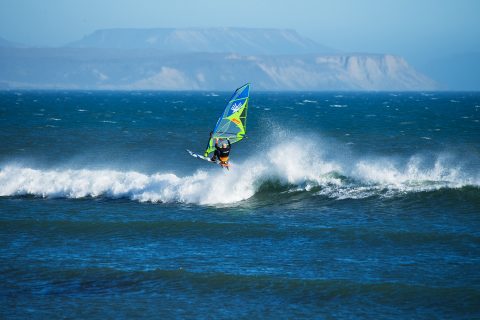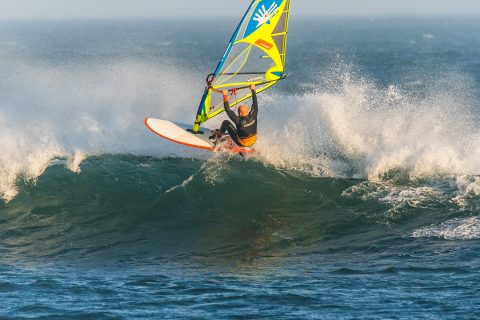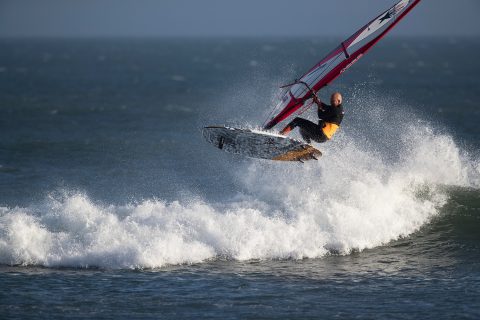JEM HALL
MOVE ON UP – WINDSURFING TECHNIQUE
AERIAL TIME
WORDS – Jem Hall
PHOTOS – Clark Merritt, Nicolas Jones, James Mellor.
AERIAL TIME
This month we look at the frontside aerial as a way to boost your wave riding and your ability to work with the wave.
I will outline its place in wave sailing and give you tips to learn and improve this move but some great advice is to just try some. As they say in Punta San Carlos, Baja, ‘You just won’t know until you go!’ I have few regrets in my windsurfing journey and the right moves came to me at the right times, yet personally I really do wish I had worked on aerials at least a decade or more ago, I was too focussed on regular top to bottom riding. With this in mind I really push my wave rippers to attack aerials when the opportunity presents.
BREAKDOWN
Let’s breakdown the move’s essentials.
Who: If you are already making some nice turns up and down the wave and can read how a wave is shaping up and also have access to some side / side-offshore waves then this move should be an aspiration.
What: This is a jump on the way in, off the breaking section of a wave and it is more about timing and finding the right part of the wave than just the action of jumping, as it is mainly the wave doing the work.
Why: It is fun, adds to your repertoire and will give you a new challenge, but mainly there are some parts of a wave where making a turn is either hard, or not worthwhile, so an aerial becomes the best option.
Where: You need to be on a wave that has a bit of power, but not too much, and to be coming from upwind to hit a section that is throwing. When learning to aerial it is best to have some distance from this section to give you the time and speed to make it.
When: This is where good old judgment and experience comes in. Go too early off the section and the wave won’t throw you, too late and you will be wearing the lip of the wave like a hat.
- After spotting the section to take off from begin to transfer weight from toes to heels.
- With the wave’s energy now going into the board it will start to project you up so dont assist this process by straightening the back leg and lift up on the boom!
- Look forward as you do the pop and almost before you do it, and way more than i am here. You are now looking to lift and fly.
- Aim to land in front of the wave, so think again look forward, lift the rail by getting your toes down and your heal right up your arse!
- Keep composed and hold your landing gear until touchdown as you look to open the sail.
- Land smoothly with a bent back leg and the sail away and be prepared to keep the tail upwind.
How: Here are my dos and don’ts.
- Good section and a later hit will give us more throw and thereby air from the wave. Credit: James Mellor
DO
- Believe in what you are about to do and be aggressive.
- Read the wave and get speed.
- Make a shallow bottom turn to help you get in front of the wave and finish the mission.
- Keep the rig forward and away as you pop off your heels.
- Look forward and really see the beach as you fly to ensure you land on, or in front of the wave and not out the back.
- Try to fly! Really bring your tail up and get that rail up with your toes down.
- Open the sail on landing and keep your back leg bent to avoid losing your fins in the white water.
- Really focus on as many attempts as you can in a session. I tried 10 in one power hour and unsurprisingly I improved and learnt a huge amount.
- Good wave to air off, just hitting it in the wrong place and too early. Credit: Nick Jones.
DON’T
- Don’t choose a really small section.
- Don’t go too slowly into it.
- Don’t oversheet or carve too hard in your bottom turn.
- Don’t keep looking at the sail when in the air, as this was where you were looking for the section.
- Don’t keep your back leg extended after the pop / contact off the lip, don’t forget you are actually jumping here.
FAULT ANALYSIS
Let’s examine some common mistakes and offer some tips to rectify them.
- PROBLEM: Going out the back of the wave. SOLUTION: Ensure you keep your bottom turn shallow and change your rails to your heelside to get the board and you projected in front of the wave and really look forward to the beach.
- PROBLEM: No pop from the wave, so no air. SOLUTION: Go later to get more pop from the section and ensure you send the nose up by pushing down on your back leg to get the nose up. Your body is more used to bending your back leg when it is making turns.
- PROBLEM: The wave breaks on you. SOLUTION: You need more speed to ensure you can make the pop and your timing could be off, through more attempts you will get better at hitting the wave at the right time, not too early or too late – just right!
- PROBLEM: Not enough height and landing on the wave. SOLUTION: Tuck up, scissor and really fly the board, in effect ‘sailing it’ through the air. It is easy for your body to forget you are actually doing a jump!
- Hit a section, pop, get that tail up and aerial. Credit: Clark Merritt.
Tips for lighter & stronger winds
I consulted John Skye for some tips to help us aerial in different conditions as well as tapping into my own sailing and coaching experiences too.
LIGHT WINDS:
- It is very important to really keep speed up and so therefore you must keep a higher line on the wave before dropping down to make your shallow bottom turn prior to the aerial.
- Upon landing remember you have less wind to work with, so land with the sail open and your body weight far forward.
- It is easier to aerial when less powered up in side-offshore winds, so attempt more in these conditions and be aware that aerials in side-shore are more challenging with less wind.
WINDY OR WELL POWERED:
- When it is very windy and side-off know that you can go very late, as the wind holds the lip up and you have plenty of speed (from the wind) to punt you up and out in front of the wave.
- Get speed along the wave in order to get the sail lighter so that you are not too powered up upon take off or in the air.
Tips for side-shore & side-off
SIDE-OFF
- This direction is in general easier as you can fly along the wave, get speed and then do a pop off lip.
- You can also go later off the lip / section in side-off as the wind holds the wave up and you have both wind power and often drive from the lip.
SIDE-SHORE
- You need more speed in this direction, as it is more challenging so ensure you keep speed in your bottom turn by holding the sail forward and not oversheeting.
- A good way to air is only drop half way down the wave and then just pop off the section you want to air off.
- A proper, more vertical, bottom turn into top turn arc into air is way harder in side-shore, so full respect to those that can. So again keep your bottom turn shallow to make more airs
RRD boards, wetsuits & softwear, Ezzy sails & Black Project fins sponsor Jem Hall. For details on his coaching holidays check out www.jemhall.com. You can also follow him on Twitter, Facebook and Instagram.


